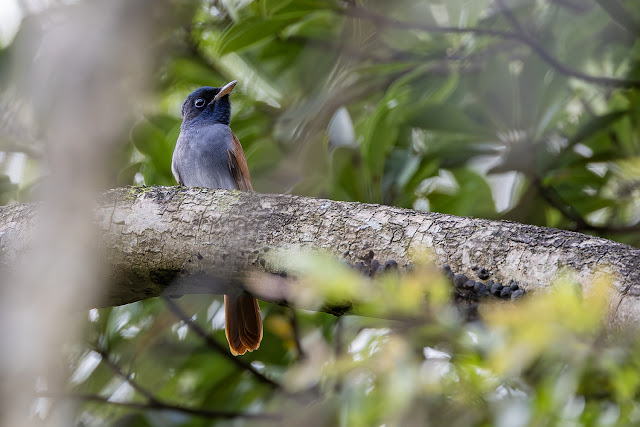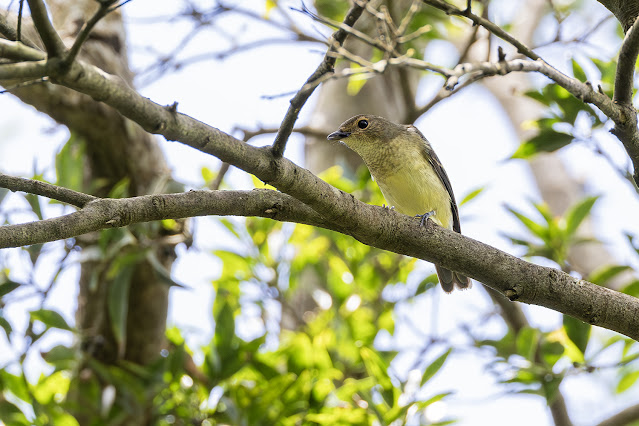Three species of Orioles have been recorded in Hong Kong before, Black-naped Oriole being a fairly common and regular passage migrant, the other two are Maroon Oriole and Silver Oriole, both having just been recorded in Hong Kong once. The Maroon Oriole record was a single bird from Po Toi, however it was later deemed as an ex-captive individual due to the race being the largely sedentory Taiwanese subspecies. The only Silver Oriole record also came from Po Toi, on November 2018, this species is globally very rare, and are known to breed in central and southern China, while wintering down in South East Asia, most records outside of China comes from Thailand, where it is a rare winter visitor. Therefore, when Tom Li posted he found a Silver Oriole up on Ngong Ping, you can imagine the excitement!
When I arrived, it was just over 2 hours after Tom sent out the news, a few birders were already there but had no luck. We walked around the supposed GPS spot without seeing much, by 12:30pm I think most of us there thought the bird might have moved on. I decided to take a walk closer to the main road, just to see if I can bump some bird activity, an Amur Paradise Flycatcher came in hawking for insects, as I was looking at the flycatcher, a much larger bird flew in briefly and out to hide behind the tree. At that moment I suspected it could be the oriole, but I did not see any details on the bird and therefore could not confirm. I waited for a few minutes when the bird finally moved and came into view, sure enough it was the Silver Oriole! I took a few photos and immediately called the other guys over. For the next hour or so the bird showed fairly well on and off. By the looks of its dark iris it should be a young bird, and likely a female.
 |
| Silver Oriole - Incredible Rarity! |
Other birds nearby along the trail includes 2 Amur Paradise Flycatchers, as well as a Yellow-rumped Flycatcher and a single male Hainan Blue Flycatcher, making for quite a nice supporting cast along that short stretch of trail behind the Big Buddha.
 |
| Amur Paradise Flycatcher |
 |
| Yellow-rumped Flycatcher - juvenile |
 |
| Hainan Blue Flycatcher - male |
I haven't birded anywhere near home for a while, Wu Kau Tang is one of my favourite place locally to check, however last winter was quiet disappointing that have resulted in me largely neglecting the site for a while. And, quietness seems to have continued onto this autumn, I failed to locate any Barred Cuckoo Dove in the valley, although I am sure they will be around somewhere...I found a fairly interesting looking immature male Fork-tailed Sunbird with some adult feathers coming through. Indochinese Green Magpie is of course a staple here in north east New Territories, however it doesn't make them any easier to get photos of. Streak-breasted Scimitar-Babblers are fairly common here, and not unusual to see a few of them during a walk here.
 |
| Fork-tailed Sunbird - juvenile male |
 |
| Indochinese Green Magpie |
 |
| Streak-breasted Scimitar-Babbler |
A female Hainan Blue Flycatcher as well as 2 juvenile Yellow-rumped Flycatchers were about the best birds I could manage on a morning walk. Pale-legged Leaf Warblers are now returning, I heard up to 2 birds but didn't want to show.
 |
| Hainan Blue Flycatcher - female |
 |
| Yellow-rumped Flycatcher - juvenile |
Wu Kau Tang is also quite well known for its dragonflies, with several usually rare or uncommon species regularly found here. The Blue-spotted Duskhawker is one of those more unusual species, I saw 3 individuals just along the stream here. Before I left I found an adult Taiwan Kukri Snake hiding behind some plants next to the footpath, I didn't want anyone killing it so I ushered it back into the bush.
 |
| Blue-spotted Duskhawker |
 |
Taiwan Kukri Snake
We just had our first typhoon of the season, a very strong typhoon Yagi that luckily mostly missed Hong Kong, as it landed further west towards Hainan Island, we got mostly strong east winds in Hong Kong, which in my experience pushes in various terns into Plover Cove, so in the morning of the typhoon I decided to head out to the dam to scan the sea, sure enough there were hundreds of terns. Mostly Common Terns, over hundreds of them! I scanned for Aleutian Terns but had no luck.
| Typhoon bringin in a lot of terns |
Common Tern
Whiskered Terns were also in fairly good numbers, many of them flew up the dam and onto the reservoir, making for quite an interesting sight.
Whiskered Tern
A few Great Crested Terns were amongst the best of the terns, I also saw a few distant Little Terns and a single Gull-billed Tern. I keep hoping for some true pelagic birds, but given how far in I am, the probability of that happening is not high.
Great Crested Tern |
























No comments:
Post a Comment